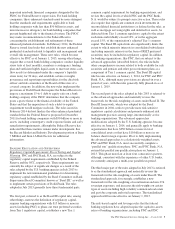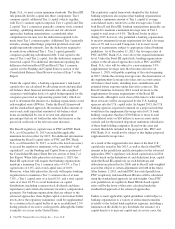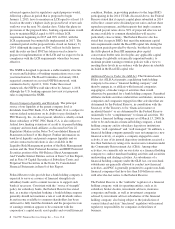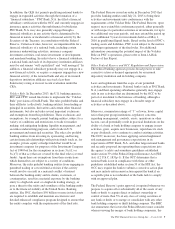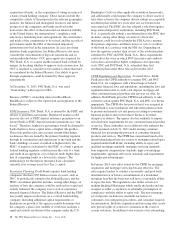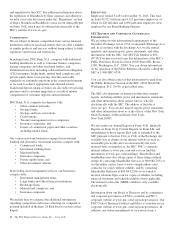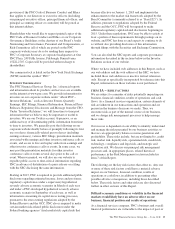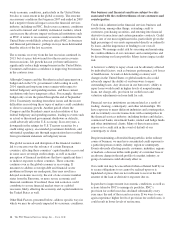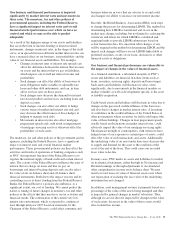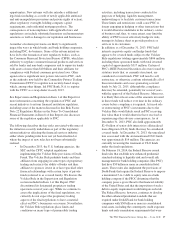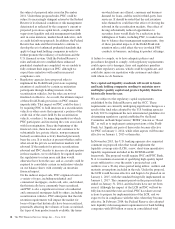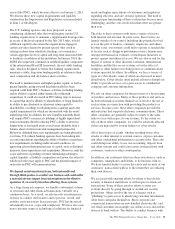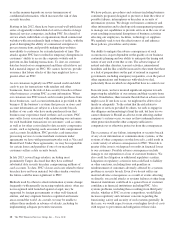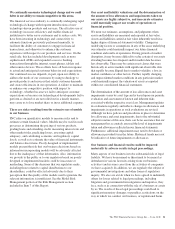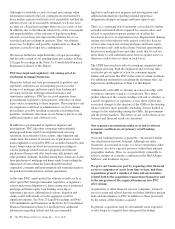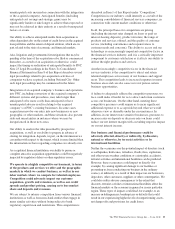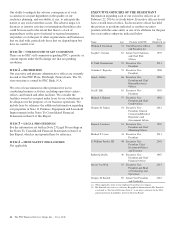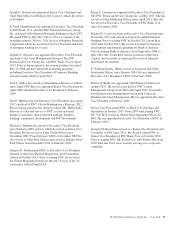PNC Bank 2013 Annual Report Download - page 33
Download and view the complete annual report
Please find page 33 of the 2013 PNC Bank annual report below. You can navigate through the pages in the report by either clicking on the pages listed below, or by using the keyword search tool below to find specific information within the annual report.Our business and financial performance is impacted
significantly by market interest rates and movements in
those rates. The monetary, tax and other policies of
governmental agencies, including the Federal Reserve,
have a significant impact on interest rates and overall
financial market performance over which we have no
control and which we may not be able to predict
adequately.
As a result of the high percentage of our assets and liabilities
that are in the form of interest-bearing or interest-related
instruments, changes in interest rates, in the shape of the yield
curve, or in spreads between different market interest rates can
have a material effect on our business, our profitability and the
value of our financial assets and liabilities. For example:
• Changes in interest rates or interest rate spreads can
affect the difference between the interest that we earn
on assets and the interest that we pay on liabilities,
which impacts our overall net interest income and
profitability.
• Such changes can affect the ability of borrowers to
meet obligations under variable or adjustable rate
loans and other debt instruments, and can, in turn,
affect our loss rates on those assets.
• Such changes may decrease the demand for interest
rate-based products and services, including loans and
deposit accounts.
• Such changes can also affect our ability to hedge
various forms of market and interest rate risk and
may decrease the effectiveness of those hedges in
helping to manage such risks.
• Movements in interest rates also affect mortgage
prepayment speeds and could result in impairments
of mortgage servicing assets or otherwise affect the
profitability of such assets.
The monetary, tax and other policies of the government and its
agencies, including the Federal Reserve, have a significant
impact on interest rates and overall financial market
performance. These governmental policies can thus affect the
activities and results of operations of banking companies such
as PNC. An important function of the Federal Reserve is to
regulate the national supply of bank credit and certain interest
rates. The actions of the Federal Reserve influence the rates of
interest that we charge on loans and that we pay on
borrowings and interest-bearing deposits and can also affect
the value of our on-balance sheet and off-balance sheet
financial instruments. Both due to the impact on rates and by
controlling access to direct funding from the Federal Reserve
Banks, the Federal Reserve’s policies also influence, to a
significant extent, our cost of funding. We cannot predict the
nature or timing of future changes in monetary, tax and other
policies or the effects that they may have on our activities and
financial results. The continuation of the current very low
interest rate environment, which is expected to continue at
least through mid-year 2015 based on statements by the
Chairman of the Federal Reserve, could affect consumer and
business behavior in ways that are adverse to us and could
also hamper our ability to increase our net interest income.
Recently, the British Bankers’ Association (BBA) took steps
to change the process for determining LIBOR. The method for
determining how LIBOR is formulated and its use in the
market may change, including, but not limited to, reducing the
currencies and tenors for which LIBOR is calculated and
requiring banks to provide LIBOR submissions based on
actual transaction data. It is uncertain what changes, if any,
will be required in the method for determining LIBOR and the
impact such changes will have on our LIBOR-linked debt or
preferred securities, or any of our loans, derivatives or other
financial assets or obligations.
Our business and financial performance are vulnerable to
the impact of changes in the values of financial assets.
As a financial institution, a substantial majority of PNC’s
assets and liabilities are financial in nature (items such as
loans, securities, servicing rights, deposits and borrowings).
Such assets and liabilities will fluctuate in value, often
significantly, due to movements in the financial markets or
market volatility as well as developments specific to the asset
or liability in question.
Credit-based assets and liabilities will fluctuate in value due to
changes in the perceived creditworthiness of the borrowers
and also due to changes in market interest rates. A lessening
of confidence in the creditworthiness of the United States or
other governments whose securities we hold could impact the
value of those holdings. Changes in loan prepayment speeds,
usually based on fluctuations in market interest rates, could
adversely impact the value of our mortgage servicing rights.
The financial strength of counterparties, with whom we have
hedged some of our exposure to certain types of assets, could
affect the value of such transactions and assets. Additionally,
the underlying value of an asset under lease may decrease due
to supply and demand for the asset or the condition of the
asset at the end of the lease. This could cause our recorded
lease value to decline.
In many cases, PNC marks its assets and liabilities to market
on its financial statements, either through its Net income and
Retained earnings or through adjustments to Accumulated
other comprehensive income on its balance sheet. We may
need to record losses in value of financial assets even where
our expectation of realizing the face value of the underlying
instrument has not changed.
In addition, asset management revenue is primarily based on a
percentage of the value of the assets being managed and thus
is impacted by general changes in market valuations. Thus,
although we are not directly impacted by changes in the value
of such assets, decreases in the value of those assets would
affect related fee income.
The PNC Financial Services Group, Inc. – Form 10-K 15


